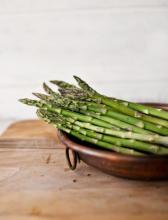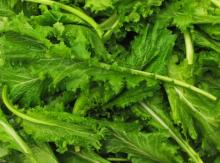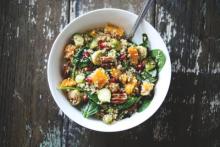Vegetables
The 5 Healthiest Spring Vegetables
When we’re growing up, we always hear that we should eat our vegetables. Our parents drilled this habit into us, and now that we’re grown up, the choice is ours—do we still eat them? If so, why do we eat them, and which ones do we focus on?
Superfoods 101: Carrots & Their Many Health Benefits
Carrots are a member of the family Apiaceae, commonly known as the carrot family. Carrots are in the genus Daucus L., which contains two species and two varieties. Fossils of carrots have been found in prehistoric lake dwellings in Switzerland and were grown in the royal garden in Babylon in the 8th century B.C. E. Carrots are thought to have been cultivated for their leaves and seeds, as there is no evidence to show the root was eaten. The plant is related to parsley, dill, celery, and parsnips, and in Europe it was a white root.
5 Healthy 5-Minute Side Dishes
Many a night I’ve been elbow deep in dinner prep or in line at the grocery store when I realize I’ve forgotten to plan for a side dish. Sure, homemade veggie burgers are great—but they’re not very substantial on their own. Maybe it’s because I’m from the Southern U.S., but I feel much more satisfied when I have a filling side dish (or two!) along with my entrée. The problem is that I’m usually much more focused on the main attraction, and it’s not unusual for the side dish to be relegated
Superfood 101: Radicchio!
Radicchio is a member of the family Asteraceae, commonly known as the aster family in the genus Cichorium L. and the species Cichorium intybus L. or chicory P.
Superfood 101: Mustard Greens!
Basically, mustard greens (sarson or rai, as they are called in India) have a superb nutrition-to-calorie ratio—which means you get the most nutrition out of a bite and don’t stack those calories either! Plus, their flavor is such that they can be made into many versatile dishes, and the taste tends to grow on you. But let’s talk about the health aspects first…
Lower Your Cancer Risk With These 5 Food Tips
In our modern world, chronic and deadly diseases are a major problem that modern medicine is struggling to fix. In 2016, an estimated 595,690 died from cancer alone. While genetics do a play a role, we are not powerless to lower our risk of this deadly disease in all of its forms.
Superfood 101: Cabbage!
Cabbage is a member of the Brassicaceae family, commonly known as the mustard family. There are 107 genera in the family; the cabbage is in the genus Brassica L. The origin of the plant is quite complicated because of the number of genera. The earliest cultivation of cabbage took place in Northern China, approximately 4000 years ago. In Europe the plant was cultivated about 3000 years ago and became a world staple. In the wild it was a leafy plant like kale and was produced in the form of a head in 14th century England.
Try Edible Landscaping
Wouldn’t it be nice to have fresh fruits, veggies, and herbs available right in your yard? If you embrace edible landscaping, you can enjoy this experience practically year-round and save money to boot. Veteran Edible Farmer Rosalind Creasy shares that while these types of gardens do require an initial investment of time and money, they offer significant savings on produce costs—for example, in 2008, the value of the vegetables she grew in a 100-square-foot garden totaled more than $675.
Build Your Own Fall Harvest Salad
Across the U.S., fall is here with the reddening of leaves, the number of pumpkin patches opening in October, and the crispness of the air, but fall is also ubiquitous in grocery stores and farmers markets.










